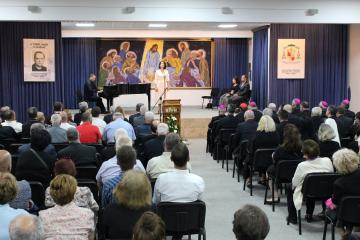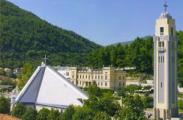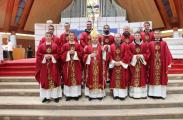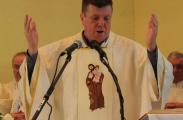Mary Mother of the Church Cathedral Hall, 21 May 2018
On Monday 21 May 2018, on the feast of Mary Mother of the Church, co-patron of the Cathedral, which is celebrated as a solemnity in Mostar, a solemn Holy Mass presided by Cardinal Vinko Puljić was held before a packed church in concelebration with ten archbishops and bishops, including the Apostolic Nuncios Luigi Pezzuto from Sarajevo and Petar Rajič from Angola, as well as about 40 priests. After the Eucharistic celebration, the main celebrant led special prayers for the deceased at the tombs of the three bishops buried in the crypt, Petar Čule, Marko Perić and Pavao Žanić. Subsequently, many of the faithful, along with religious sisters, seminarians, priests and bishops, went down to the cathedral hall to participate in the commemorative symposium. Along with the musical interludes of Lucija and Ksenija, as well as the introductory words of Msgr. Željko Majić, Vicar General, the master of ceremonies Ana invited a good number of participants to present their, "five minute", testimonies on Bishop Pavao Žanić:
Most Rev. Marin Barišić, Archbishop of Split-Makarska;
Most Rev. Petar Rajič, Apostolic Nuncio to Angola;
Most Rev. Mate Uzinić, Bishop of Dubrovnik;
Father Ivan Ševo, O.F.M., Vicar of the Franciscan Province of Herzegovina;
Father Ivo Šutalo, Episcopal Vicar for the Diocese of Trebinje-Mrkan and parish priest in Trebinje;
Mr. Srećko Vučina, who spoke on behalf of the lay faithful.
Bishop Žanić's recently published collection of works: U vjeri, nadi i ljubavi - In Faith, Hope and Charity, was presented by Most Rev. Želimir Puljić, Archbishop of Zadar, President of the Bishops' Conference of Croatia. All the written testimonies deserve a special place in the planned future anthology.
The closing words were articulated by Most Rev. Ratko Perić, the local Bishop, who read his introductory and final part, and here now we publish his entire written text along with the conclusion of the "Year of Bishop Žanić".
I met Father Pavao Žanić for the first time when I was a newly ordained priest in Rome in June of 1970 and he was the Rector of the Minor Seminary in Split. He led thirty seminary-graduates on a pilgrimage to the Eternal City and it fell upon me to be their guide from the Vatican to the Lateran and surroundings. Towards the end of that same year he was appointed bishop-coadjutor of Mostar. From then on until his death, for 30 years I followed his episcopal ministry and life from Trebinje, Sarajevo, Rome and Mostar after his retirement. If true friendship is described as "idem velle, idem nolle" – agreement in likes and dislikes, as the late Sallust would say, then I can modestly say that I have endeavored to listen to the voice and follow in the footsteps of Bishop Pavao who was a truthful, upright and fearless Pastor. Like the biblical metaphor that Joshua pronounced: “Sun stand still at Gibeon, and Moon, in the valley of Aijalon!” (Js 10:12), we too would like to "stop" the 23 sunsets of Bishop Žanić’s years in the valley of Mostar and observe them from this historical distance on the centenary of his birth.
The Draft Plan of 9 May 2017 regarding “The Year of Bishop of Žanić”, on the Centenary of his birth (1918 - 2018), by God's grace became an Implementation Plan. The course of the Year was solemnly marked, first of all by the publication of 11 significant articles in the diocesan monthly magazine “Church on the Rock”, followed by a commemorative Mass on the anniversary of his passing on 11 January 2018, then by the publication of a collection of works dedicated to him entitled: U vjeri, nadi i ljubavi - In Faith, Hope and Charity, and by the crowning event of the transfer of his bodily remains from Kaštel Novi (Croatia) to the bishops’ crypt in the Cathedral of Mostar on the 2nd of this month.[1] As with every academic project, such as this one on the Year of Bishop Pavao, during its implementation, various practical improvements and adjustments were made towards the set purpose. The purpose was to evaluate the doctrinal-sacramental-administrative activities of the Bishop, initially as Coadjutor-bishop for 10 years (1970-1980) and then as Ordinary for 13 years (1980-1993), his systematic planting of pastoral seeds, which over time developed and brought forth fruit to this day.[2]
As a faithful coadjutor alongside the Ordinary Petar Čule, he followed all the activities with all his co-responsibility, thereby offering to this local Church all “five talents” along with the other five acquired (Mt 25: 15-16):
From 1971, the Herzegovinian Affair. Even though the Holy See immediately after his episcopal ordination in 1971 entrusted him with resolving the “affair” - because the other side promised that the question would be resolved immediately if a bishop was appointed in Mostar from outside of Herzegovina - he asked that everything remain in the hands of Bishop Petar and that he would do whatever he could. Thus, a mixed commission comprised of diocesan clergy headed by the coadjutor Pavao and Franciscan clergy led by the Provincial Superior or his Vicar was formed. The commission met three times that year: in Bijelo Polje, Mostar and Humac. Nothing was resolved, instead it all became even more heated. In August of 1972, Bishop Stefan Laszlo of Eisenstadt in Austria, was appointed as Apostolic Visitor for Herzegovina. Several meetings were held under his leadership in Zagreb in the autumn of 1972, then in July and September of 1973. There were no results. The BCY (Bishops’ Conference of Yugoslavia) was included, but again no progress was made. Then meetings were held in front of Representatives of the Holy See in Rome in February of 1974. Finally, the Papal decree Romanis Pontificibus was issued on 25 June 1975, approved by Pope Paul VI. in specific form – in forma specifica. Due to the non-implementation of the Decree, sanctions were then imposed which were still in effect even after the Bishop's retirement in 1993.[3]
From 1971, with the erection of new parishes, the coadjutor Pavao stood alongside the Bishop Ordinary Petar, in all things. With the arrival of numerous new priests (from 1969 to 1975: 42 newly-ordained diocesan priests), 10 new parishes were established, namely 5 in the diocese of Trebinje-Mrkan: Hutovo 1971, Čeljevo, Stjepan Krst and Neum 1974, Aladinici 1977, and 5 in the diocese of Mostar-Duvno: Raskrižje 1971, Vinjani Hercegovački 1972, Gabela Polje 1977, Zagorje and the Cathedral 1980.
Bishop Žanić as Ordinary, erected another 5 parishes in the diocese of Mostar-Duvno: Gorica-Struga 1988, and four parishes in the city of Mostar, dedicated to the four holy evangelists: Matthew, Mark, Luke and John, 1993. He closely followed as best as he could, the construction of the churches and parish rectories. In this area he showed a sensible strategy in the administration of both dioceses. In all of this, he manifested special care for the minor and major seminarians, while at the same time, he maintained a sincere relationship with the diocesan and religious priests.[4]
The theme of the Family was particularly close to his heart from the early days as Coadjutor in 1971 and then as Ordinary from 1980 onwards. He devised various pastoral strategies - lectures, films, meetings, messages, articles - to improve the situation of families in Herzegovina.[5] For more than 20 years he was the President of the Commission on the Family at the BCY and member of the Pontifical Council for the Family. He was open to the needs of the missions in the Third World through financial aid and in particular by sending priests ad gentes. He once spent a month in 1983, visiting Croatian missionaries in Tanzania and Zambia.[6]
The construction of the Cathedral which began in 1975 was under his supervision and he participated in the celebration of the consecration of the Mary Mother of the Church Cathedral in 1980, when he took over the administration of the dioceses. He also oversaw the construction of a retirement home for priests in 1981 and the restoration of the Chancery building and residence in 1982.[7] All three of these large buildings were devasted during the war in 1992 and remained out of use for several years. At that time, the Bishop felt like the biblical Job, to whom everybody came to inform him every so often of catastrophic storms and thunder from the sky. Even though he was overwhelmed by the destruction of the large buildings to which he invested his health and his hopes, he remained faithful to his ministry to the very end, loyal to God and to the Holy See. A thorough restoration of these buildings was necessary, and he was able to bless some of them.
In 1977, the Shrine of the Queen of Peace. Bishop Žanić was known as a Marian devotee who simultaneously spread a healthy devotion to the Blessed Virgin Mary. He gave his full support to the creation of the Shrine of the Queen of Peace in the diocese of Trebinje-Mrkan in 1977, erected by Bishop Petar. For over eight years, Bishop Žanić led the liturgical celebration of the Queen of Peace at Hrasno on the second Sunday of May (1978-1979, 1980-1985, 1989), preaching and encouraging pilgrims to pray to Jesus' physical and our spiritual Mother.
Bishop Pavao was highly regarded as a preacher and a successful leader of pilgrimages both at home and abroad, especially during his time as Coadjutor.[8]
In 1980 he established the monthly magazine “Church on the Rock”, as the primary source of information and pastoral aid. During his administration, despite the war, the monthly was published in 150 uninterrupted issues. Over the years, the monthly has gathered more than 30 priestly authors and the Bishop himself most often participated with his introductions, statements or reviews. The foundations of the periodical were set so well that so far 450 issues had been published. Since 2003, that is, for the last 15 years, the monthly has been extended to 42 pages. The publishing house under the same name, which is also the work of Bishop Žanić, published 30 books during his time and to this day, a total of 150 titles. These books are an indisputable source of not only pastoral information, but also of systematic teachings in the Magisterium, spirituality, morality, and national education.[9]
From 1981 he followed the Medjugorje phenomenon from the beginning and personally suffered profoundly because of all the contradictions regarding the “apparitions”, “messages”, “secrets” and disobedience. From 12 October 1981, the apparition in Medjugorje presented herself as the “Mother of God and Queen of Peace”, yet since 2 February 1982, she recommends that the “Feast of the Queen of Peace” be celebrated on 25 June, because the people began to gather on the Podbrdo mountain that day. Over time, he both personally and through two commissions, studied the phenomenon, engaging the Episcopal Conference and the Holy See in seeking out the truth on the enigmatic manifestation. In connection with this question, he published Church instructions and decisions in February 1982, in October 1984, in July 1987 and in May 1990.[10] In 1985 he wrote: “I’m racked with pain for my Mother the Church who will experience a great scandal [...]. I’m racked with pain for the dear Madonna who has become an ‘office teller’”.[11]
Through the affair and the phenomenon, he was exposed to the world and he held himself bravely in relation to the curious world media and religious fanatics. “I know that there will be good, pious souls that will not understand me, and I will look like an enemy of the Madonna. I have been to Lourdes several times and in other shrines related to apparitions approved by the Church. I am defending the truth, defending the Holy Church, and I pray to God that I will be able to sacrifice my life for this.”[12] Can there be any greater testimony?!
He was a co-organizer in 1981, along with the other bishops of the Metropolitan see, and a participant of the 100th anniversary celebration of the re-establishment of an ordinary Church hierarchy in Bosnia-Herzegovina and the leader of the Herzegovinian Pilgrimage of gratitude in Rome in 1982.
Soon afterwards, in 1984, he was the main promoter of the celebration of the 1000th anniversary of the Diocese of Trebinje-Mrkan and he obtained from the Holy See a decree elevating the one hundred-year old parish church in Trebinje to the Cathedral of Trebinje.[13]
He established the Diocesan Caritas in 1982, which along with the monthly Church on the Rock, has become the main tool of pastoral activity, which over time expanded into various departments and today employs nearly 80 people.[14]
In 1987 he opened a Theological Institute, which due to communist terror had to be closed or renamed into Adult Catechism, however in 1993 the original titled was re-established as the Theological Institute of Mostar, which was also approved by the Holy See as a university institution last year. The institute gathers qualified priests and laypeople as lecturers, and in the 30 years from 1987 to 2017, out of 609 enrolled students, 244 graduated as catechists or high school teachers. All this was possible because reasonable plans were put in place that could withstand in the long-term, as Bishop Žanić imagined them and with valuable co-workers.[15]
“Collaborator” or “enemy” of the communist regime? He was followed by the enemies of God and the Church through technical and operational aids in Split as well as in Mostar, and there were several informants who reported the Bishop's words and moves.
Police profile - Between 1941 and 1971 – “... he did not sympathize with Pavelić, but according to his statements, ‘following the traditions of his fathers, he sympathized with the policies of Radić and Maček and above all was for Croatia as an independent state.’ [...] He began his enemy activity against the social order immediately after the war through verbal instances in front of likeminded people. Through his sermons to believers he often abused religion for political purposes, spreading disbelief in the stability of the order, attacking atheists, the socialist system, he called communism the “ideology of confiscation”, spoke of the inevitability of a Third World War as the only way to ‘get rid of the savages’ /1947./. He advocated refusing any kind of co-operation with the authorities, with whom any dialogue should be 'harsh and disobedient' because cooperating with the authorities means helping them to 'liquidate us' /1964./. Communism he said, will collapse because it is ‘the cause of all the misery in the world.’ - In Split, he gathered around himself a group of extremist priests and reactionary intellectual clerics. In that circle, he took severely hostile enemy positions, attacking the socialist system and communism in general. He is actively monitoring developments in the country and in the world, and all that is negative he attributes to communism and socialism. He is a critic of all the measures that are being undertaken regarding international relations and self-management. Through such positions he was stirring up national and religious intolerance. In a vulgar way, he insulted, slandered the highest state-party leadership, especially comrade Tito.” This is from the secret report on the priest and Bishop Pavao Žanić in October of 1971.
AN ENEMY, NON-COLLABORATOR BETWEEN 1971 TO 1990 – “How is it that not even a single document ends with Žanić's name as a ‘source’ but always a ‘an enemy operator’? Can a person who is considered all the time as an enemy operator at the same time be a collaborator?! The Split SDS - Secret service and the Mostar SDB, in their time, also concluded that there is no longer any need for operational processing – that is, for following Bishop Žanić's work. But the Mostar SDB did this only in 1990 when Bishop Žanić was no longer considered fit for military service – with his removal from the Defense Plan and considered incapable for exceptional circumstances – with his removal from the Extraordinary Opportunities Plan which, by chance or not, also coincided with the collapse of Yugoslavia”.[16] He could have found satisfaction in seeing the collapse of communism as an inhumane and ungodly system that for 45 years oppressed local peoples and nations, and wanted to eradicate religion or at least subjugate it towards their malicious goals. Neither succeeded.
Conclusion. This Jubilee Year has shown that we had in the person of Pavao Žanic a Bishop of national rank, a lover of truth and justice, a marvelous builder of human, family and ecclesiastical relations, a virtuoso of faith, hope and charity, a sharp and indomitable opponent in the classical position of religion and nation, towards the ungodly regime. Enriched with new knowledge gathered in this second tome, dedicated to him in gratitude, we hereby proclaim and conclude the “Year of Bishop Žanić”, thankful to God for his magnanimous gift! We believe that even more will be said and written on this faithful servant of the Lord in the future, in an even greater and better way, to the glory of God's love and truth, to the honor and respect of Bishop Pavao and to the benefit of our local Church.
[2] Cf. T. Vukšić, Editor, Istina oslobađa (The Truth Liberates), Zbornik – Collection of works on Bishop Žanić, Mostar, 1992.
[3] Cf. M. Krešić, „U rješavanju 'hercegovačkoga slučaja'“ (In Resolving the Herzegovinian Affair) in: Ž. Majić – B. Goluža, Editors, U vjeri, nadi i ljubavi, (In Faith, Hope and Charity) Mostar, 2018., p. 177-219.
[4] Cf. L. Pavlović, „Briga za duhovna zvanja i odnos prema svećenicima“ (Concern for vocations and relations with priests) Idem, pp. 81-85.
[5] Cf. K. Puljić, „Promicatelj kršćanske obitelji“ (Promoter of Christian Families) Idem, pp. 46-61.
[6] Cf. I. Štironja, „Doprinos misijskom poslanju Crkve“ (Contributions to the Missionary works of the Church), Idem, pp. 71-80.
[7] Cf. A. Šarac – A. Luburić, „Graditeljska nastojanja, djelatnost i brige“ (Architectural endeavors, works and concerns) Idem, pp. 153-176.
[8] Cf. M. Šutalo, „Pastoralac“ (Pastoral Shepherd of Souls) Idem, pp. 62-69.
[9] Cf. B. Goluža i I. Drmić, „Osnivatelj Crkve na kamenu“, (Founder of Church on the Rock), Idem, p. 31-43.
[10] Cf. I. Turudić, „U potrazi za istinom o 'međugorskom fenomenu'“ (In Search of the Truth on the 'Medjugorje Phenomenon'), Idem, pp. 221-238.
[11] The letter of Bishop Žanić to Fr. René Laurentin, 29 January 1985, Prot. 100/1985.
[12] P. Žanić, Međugorje (Medjugorje), Mostar, 1990, p. 16.
[13] Cf. I. Puljić, „Apostolski administrator Trebinjsko-mrkanske biskupije“ (Apostolic Administrator of the Diocese of Trebinje-Mrkan), in: U vjeri, nadi i ljubavi, pp. 87-98.
[14] Cf. A. Komadina, „Utemeljitelj Biskupijskoga caritasa“ (Founder of the Diocesan Caritas), Idem, pp. 99-120.
[15] Cf. A. Pavlović, „Utemeljitelj Teološkoga instituta u Mostaru“ (Founder of the Theological Institute of Mostar) Idem, pp. 121-151.
[16] Cf. Ž. Majić, „Čovjek neustrašivi“ (A Fearless Man), Idem, pp. 239-262.




